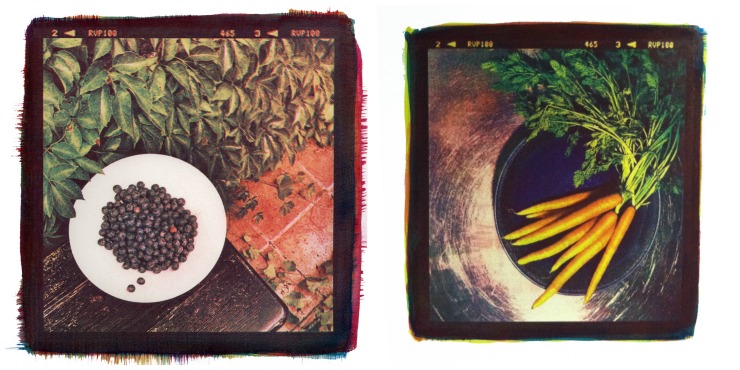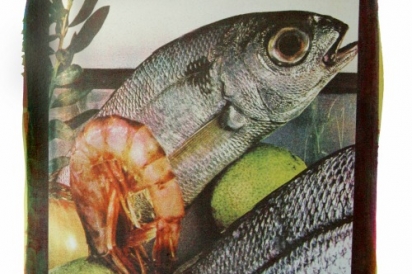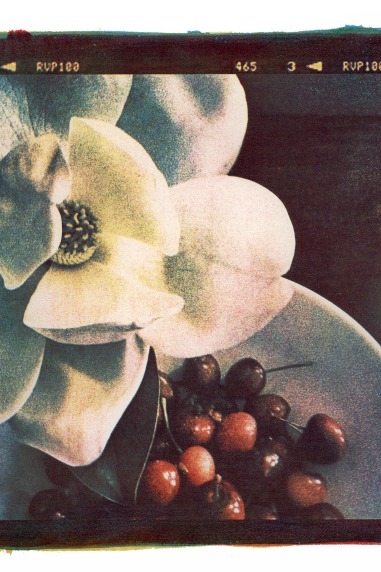A Professor, A Farmer and An Artist Walk Into A Bar...
He pulled the gallon bag out of his briefcase. It held about a quart of brown-and-cream flecked coarsely-ground meal. He handed it to me. It was cool to the touch, not long out of the refrigerator.
I hesitated. Should I say thank you? That would be presumptuous; what if he wasn’t giving it to me? Maybe he just wanted to show it to me. What was it? He smiled.
Chestnut meal, milled by Glenn Roberts at Anson Mills, had just been gifted to me by Dr. David Shields: food historian, heritage vegetable expert, and chair of the Slow Food Southeast Ark of Taste Nominating Committee.
“For chestnut skillet bread,” he said.
“Taste it.”
I opened the bag, took a pinch, and dropped it into my mouth, scattering the meal from my chin down to my waist. Neither of us cared. He was waiting for my reaction.
It was rich and nutty, conjuring fantasies of crusty brown bread, baked in a cast iron skillet, slathered with butter.
Chestnuts had long been on my radar, thanks to the book 1491: New Revelations of the Americas Before Columbus, which described the Americas before the arrival of Columbus. Squirrels could travel from Maine to Florida in the forest canopy, tree to tree, never touching the ground. In some areas, including the Upstate, one out of every four trees in those forests was a chestnut— until logging and an imported Asian blight sent our native trees into near-extinction. Dr. Shields says Dr. Joe James at Chestnut Return Farms in Seneca is restoring the American chestnut, carefully breeding for resistance to blight and other diseases with the help of a team from Clemson University and The American Chestnut Foundation.
We talk about the hunt for other plants long gone. Dr. Shields mentions pre-1900 strawberry varieties, of special interest because Charleston once was a center of strawberry breeding. He’s visited scores of people in search of those varieties, including Hovey strawberry and Neunan’s Prolific. “Many people say they have them. They don’t. They’re liars,” he says emphatically. This is serious stuff— to him, and to me.
Most people involved with Slow Food in South Carolina would agree that David Shields and Glenn Roberts are synonymous with the movement, but overnight successes, they are not. Roberts has been working on the revival of heirloom grains since the 1990s. The two met at a conference hosted by Shields in 2002, where David asked about Lowcountry cuisine. Roberts replied that it couldn’t really be called a cuisine, since normally “cuisines” were based on products traditionally grown in the region. To resurrect those varieties for the Lowcountry, they needed the help of a skilled researcher. They needed a detailed history, and a template to fill in missing ingredients. Was Dr. Shields interested?
Indeed he was. Already a renowned (and busy) expert in other fields, he jumped into the research whole-heartedly. He spent hours combing through microfilm. The hours turned into days, and then into years. He read 1800s agricultural journals and learned how the heirloom varieties were grown and prepared. He familiarized himself with the distinguishing traits of those varieties, and with the help of agricultural scientists, began identifying the critical genomic markers for each. That said, the process of identification is more an art than a science. Genomically, even with Carolina Gold Rice—the Lowcountry object of study for years now—the best they can do is to identify the most distinguishing features. Often, physical characteristics play as large a role in the identification as genetic markers. The Carolina Runner African Peanut, for example, is decidedly smaller than the popular Virginia Peanut, and yields a very high-quality, delicate oil, responsible for its popularity among French Castile soap makers in the 19th century. (It has been nominated for the Ark of Taste this year.)
In 1998, not long before Roberts and Shields joined forces, photography teacher and artist Debbie Cooke visited Cortona, Italy, as part of the University of Georgia’s study-abroad program. One evening, she had the opportunity to attend a dinner where various food aficionados and producers prepared a meal from locally-sourced ingredients. The food was simple, but the flavors exquisite. The taste of the local ingredients “hooked her” and made her want to recreate the movement back home.
The evening offered more than just good food, though. It was about conversation, ingredients, people who grew the ingredients, chefs from the area, traditional preparation and sharing knowledge of cooking methods: “As food was done in the South when I was a girl,” she says, “Grandmother taught mother, mother taught daughter.” She remembers learning there was a time of the year to eat pork, a particular recipe that called for a cast iron skillet— seasons in the kitchen, too.
When Cooke returned from her trip, she founded Palmetto Slow Food. The chapter covered the entire state, with an initial membership of 20-25 people. Pulling everyone together for meetings was challenging but exciting. They met for a traditional eastern Carolina pig cooking in Florence, a wine tasting in Greenville. And they were pioneers. Their 1999 founding was preceded only by Alice Waters’ Berkeley chapter and a Research Triangle chapter in North Carolina: in fact, they pre-dated Slow Food USA by a year. Along with Bob and Victoria Chance and Dr. Roy Fluhrer, Cooke chose their first Ark of Taste nomination: Carolina Gold Rice.
As membership and interest grew, Palmetto Slow Food split into Upstate, Columbia and Charleston chapters, each with its own character and identity. Slow Food Upstate grew steadily under the guidance of Debbie and Jennifer Sparks, chapter leader from 2007-2009. In 2009, Janette Wesley took the helm. One of Janette’s most critical priorities was founding the first Slow Food Earth Market in the US, a market where vendors are required to provide products without pesticides, herbicides, hormones, steroids or genetically modified organisms. Every part of the production process must be natural, or organically and sustainably practiced. Janette and her husband, Renato Vicario, are so committed to the principles of the Slow Food movement that they have developed their own olive oil and wine production businesses.
My conversation with Dr. Shields continued with short videos of the dinner he and Glenn Roberts held last year, featuring the first roasted chestnut-fed wild hog eaten in a century. Bradford watermelon pickles are nestled against the meat. The reintroduction of the Bradford watermelon was the result of serendipity. Nat Bradford, great-grandson of the melon’s creator, found Shields’ American Heritage Vegetables website while researching the history of the fruit he’d been growing on his family’s property for generations.The conversations that followed led to a cooperative effort among Shields, Roberts, Bradford and Sean Brock (of Charleston restaurants McCrady’s and Husk) to produce watermelon molasses.
Last year, after reading an article about the molasses (which used a sorghum evaporator to extract the watermelon juice, and then a long, slow simmer), I made my own small batch from one watermelon. After hours on the stove, the gallon of melon juice reduced to a small jar of beautiful reddish-brown gooey molasses, ready to sweeten tea or sit atop a fluffy biscuit. I understand this sort of thing intimately.
We talk about other Ark of Taste heirloom varieties that I have grown and loved, among them Sea Island Red Peas. And then I notice a bowl of small white dried peas on his desk. Rice peas, he says, all but extinct in modern production. He offers them to me to grow out. I scoop them into an envelope, and slide the envelope into the sleeve of my laptop case, where it will be secure. I hug the bag of chestnut meal to my chest, double-check the seal on the seed envelope, and head home. It’s Christmas at my house.






